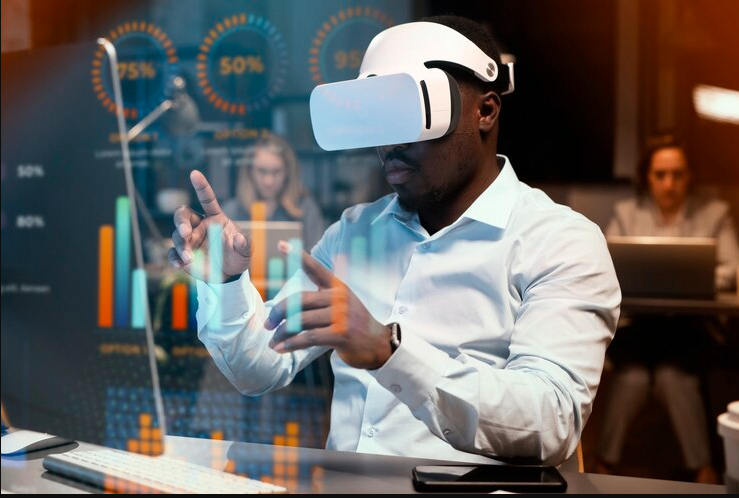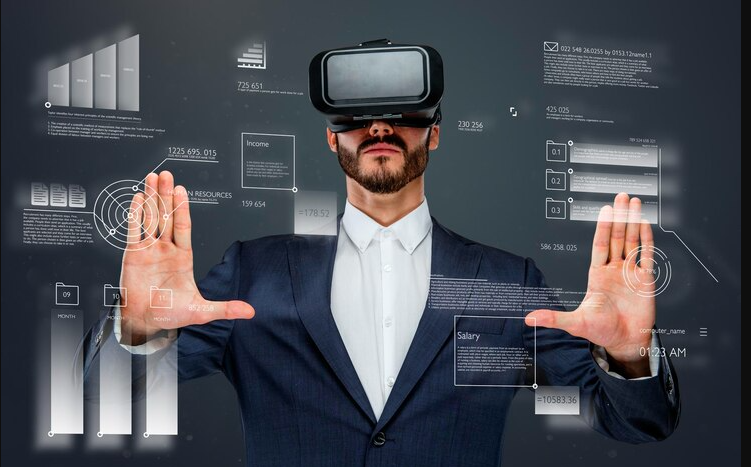From immersive simulations to enhanced training environments, the integration of AR and VR is reshaping the way we interact with the digital and physical worlds.
Augmented Reality (AR) and Virtual Reality (VR) have emerged as transformative technologies with wide-ranging applications across various industries.
In this comprehensive exploration, we delve into the simulations and diverse applications that define the realm of augmented and virtual reality.
I. Understanding Augmented and Virtual Reality
1.1 Augmented Reality (AR)
Augmented Reality overlays digital information onto the real-world environment, enhancing our perception by adding virtual elements.
AR is often experienced through devices like smartphones, smart glasses, or heads-up displays.
1.2 Virtual Reality (VR)
Virtual Reality, on the other hand, immerses users in a fully digital environment, completely replacing the real world.
VR is typically experienced using headsets that create a simulated reality, isolating users from their physical surroundings.
1.3 Wow Internet and the Need for High-Speed Connectivity
The seamless experience of AR and VR heavily relies on high-speed internet connectivity.
Providers like Wow Internet offer the bandwidth required for smooth and responsive AR and VR applications, ensuring an uninterrupted and immersive user experience.
II. Simulations in Augmented and Virtual Reality
2.1 Training Simulations
AR in Training
AR simulations find extensive use in training scenarios.
For instance, AR overlays step-by-step instructions onto real-world equipment, aiding technicians in maintenance tasks.
This practical application enhances learning outcomes and reduces errors.
VR in Training
VR takes training simulations to a new level by creating entirely virtual environments. From medical procedures to pilot training, VR simulations allow users to practice and refine their skills in a risk-free setting.
2.2 Educational Simulations
Interactive AR Educational Apps
In education, AR applications bring textbooks to life. Students can use AR-enabled devices to explore 3D models, and historical events, or even conduct virtual science experiments, making learning more engaging and interactive.
Virtual Field Trips with VR
VR enables immersive virtual field trips, transporting students to historical landmarks, outer space, or underwater ecosystems. This technology breaks down geographical barriers and provides experiential learning opportunities.
2.3 Medical Simulations
AR for Medical Training
AR is revolutionizing medical training by allowing practitioners to visualize anatomy in real time during surgeries. This technology assists in precise procedures and enhances the understanding of complex medical scenarios.
VR for Therapy and Rehabilitation
VR finds applications in therapy and rehabilitation by creating virtual environments for patients. These simulations aid in physical and psychological rehabilitation, providing a controlled and monitored setting for recovery.
III. Applications Across Industries
3.1 Industrial and Manufacturing
AR for Assembly Line Assistance
In manufacturing, AR assists workers by providing real-time information and guidance on assembly lines. This leads to increased efficiency, reduced errors, and enhanced productivity.
VR for Design and Prototyping
VR is instrumental in the design phase, allowing engineers and architects to visualize and interact with 3D models. This immersive experience aids in identifying design flaws and refining prototypes.
3.2 Retail and E-Commerce
AR for Virtual Try-Ons
In retail, AR facilitates virtual try-ons, allowing customers to see how products look on them before making a purchase.
This reduces returns and enhances the online shopping experience.
VR for Virtual Shopping Environments
VR creates virtual shopping environments where users can browse products in a lifelike setting.
This immersive approach to online shopping bridges the gap between brick-and-mortar and e-commerce experiences.
3.3 Entertainment and Gaming
AR in Live Events
AR enhances live events, concerts, and sports by overlaying additional information, graphics, or interactive elements onto the real-world experience.
This technology adds an extra layer of engagement for the audience.
VR Gaming Experiences
VR transforms gaming by placing users in the center of the action.
From realistic simulations to fantastical worlds, VR gaming offers an unparalleled level of immersion and interactivity.
IV. Future Trends and Innovations

4.1 Advancements in Hardware
AR Glasses and Smart Devices
Advancements in AR glasses and smart devices are making AR more accessible.
The development of sleek and user-friendly AR wearables is driving widespread adoption in various industries.
Wireless VR Headsets
Wireless VR headsets are becoming increasingly popular, offering users more freedom of movement.
This shift eliminates the need for tethered connections, contributing to a more immersive VR experience.
4.2 Integration with Artificial Intelligence (AI)
AI-Powered AR Applications
The integration of AI with AR enhances object recognition, enabling more sophisticated and context-aware AR applications.
This synergy results in smarter and more personalized user experiences.
VR Environments Enhanced by AI
In VR, AI contributes to creating dynamic and responsive virtual environments. AI algorithms adapt scenarios based on user behavior, making VR simulations more realistic and personalized.
4.3 Expanded Use in Healthcare
AR for Remote Medical Assistance
AR is expected to play a significant role in remote medical assistance.
Surgeons can receive real-time guidance during procedures, and medical professionals can collaborate seamlessly across distances.
VR for Mental Health Therapies
VR’s potential in mental health therapies is expanding. VR environments are being utilized for exposure therapy, stress reduction, and treating conditions like PTSD, providing innovative therapeutic solutions.
V. Overcoming Challenges in AR and VR Implementation
5.1 Technical Challenges
Hardware Limitations
Addressing hardware limitations, such as the bulkiness of AR devices and VR motion sickness, remains a priority for developers. Ongoing advancements aim to make AR and VR experiences more comfortable and accessible.
Content Development Complexity
Creating engaging AR and VR content requires specialized skills. Simplifying content development tools and frameworks is essential to encourage broader participation and innovation.
5.2 Privacy and Ethical Considerations
Data Security in AR Applications
AR applications often involve collecting and processing real-world data. Ensuring robust data security measures is crucial to protect user privacy and prevent unauthorized access.
Virtual Reality and Psychological Impact
The psychological impact of prolonged VR use is a subject of study. Striking a balance between immersive experiences and potential psychological effects is vital for responsible AR and VR implementation.
5.3 Integration Challenges in Industries
Resistance to Change in Traditional Industries
Certain traditional industries may resist the adoption of AR and VR due to concerns about disruption and the learning curve associated with new technologies. Overcoming this resistance requires effective change management strategies.
Cost of Implementation
The cost of implementing AR and VR solutions can be a barrier for some organizations. As technology matures, efforts to reduce costs and increase accessibility will drive wider adoption.
Technical Challenges
2.1 Hardware Limitations
The widespread adoption of AR and VR faces challenges related to hardware limitations.
AR devices, such as glasses, may be perceived as bulky or uncomfortable, hindering user acceptance. VR, on the other hand, grapples with motion sickness issues, making it crucial for developers to design more ergonomic and user-friendly hardware.
2.2 Content Development Complexity
Creating engaging content for AR and VR experiences requires specialized skills, often limiting the number of developers proficient in these technologies.
The complexity of content development tools and frameworks poses a challenge, necessitating efforts to simplify these processes for broader participation and innovation.
Privacy and Ethical Considerations
3.1 Data Security in AR Applications
AR applications often involve the collection and processing of real-world data, raising concerns about data security and user privacy.
Ensuring robust data security measures is imperative to prevent unauthorized access and protect sensitive information.
3.2 Virtual Reality and Psychological Impact
The psychological impact of prolonged VR use is a subject of study and consideration.
Striking a balance between immersive experiences and potential psychological effects is essential for responsible AR and VR implementation.
Addressing concerns about the mental health implications of extended virtual reality use is critical for user well-being.
Integration Challenges in Industries
4.1 Resistance to Change in Traditional Industries
Certain traditional industries may resist the adoption of AR and VR due to concerns about disruption and the learning curve associated with new technologies.
Overcoming this resistance requires effective change management strategies, education on the benefits, and showcasing successful implementations within similar industries.
4.2 Cost of Implementation
The cost of implementing AR and VR solutions can be a significant barrier for some organizations.
While prices are expected to decrease over time, initial investments in hardware, software, and training can be substantial.
Efforts to reduce costs and increase accessibility will play a crucial role in driving wider adoption across various sectors.
Conclusion
As AR and VR technologies continue to evolve, their simulations and applications redefine industries and human experiences.
Whether in training, education, healthcare, or entertainment, the immersive nature of AR and VR enhances interactions and opens new possibilities.
The future holds promising advancements, driven by innovations in hardware, AI integration, and expanded healthcare applications.
Overcoming challenges, such as technical limitations and privacy concerns, will pave the way for a more inclusive and integrated AR and VR landscape.
For users seeking a seamless AR and VR experience, a reliable internet connection is essential. Providers like Wow Internet offer the high-speed connectivity required for immersive simulations and applications.
As we journey into an augmented and virtual future, the collaboration of robust technology and connectivity will shape the way we perceive and interact with the digital realm.


Leave a Reply